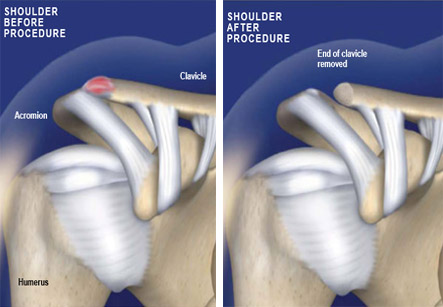Distal Clavicle Excision
Introduction
The collar bone or clavicle meets the tip of the shoulder blade (scapula) which forms the roof of the shoulder joint. This tip is called as acromion and the joint thus formed is known as acromio-clavicular (or AC) joint.
The patient can recover fully in about two months. The recovery time is less after arthroscopic surgery.
This joint is protected by the tendons of the shoulder and the fluid-filled sac called as bursa. Overuse of the shoulder can cause bursitis and tendonitis known as impingement. Impingement causes the tissues underneath the AC joint to be pinched against the bone, causing irritation and pain. This can lead to development of arthritis in the shoulder if left untreated. Physical therapy, medication, or cortisone injections are used as conservative methods of treatment. But when these treatments fail, surgery may be necessary.
Before the Procedure:
1. A proper history, examination and few lab tests and scans are done to determine the general health.
2. The surgeon usually orders X-Rays, an MRI, CT Scan, or EMG to look into the joint before the procedure.
Iran ranks among the top 10 countries in orthopedics and Iranian surgeons perform high quality orthopedic surgeries at highly affordable prices

3. Patient should stop anti-inflammatory drugs like aspirin at least a week before surgery.
4. Medications being taken for other conditions like diabetes, heart disease, blood pressure should be continued with advice from the treating doctor.
5. History of smoking or alcohol drinking should be told to the surgeon. Smoking should be stopped if possible as it interferes with the wound healing.
6. Recent history of cough, cold, fever, viral infections, or other illnesses should be informed to the surgeon.
7. Patient is not allowed to eat or drink anything at least 8 to 12 hours before surgery except essential medicines with sips of water.
8. Make sure to receive all the equipment needed after going home like a shoulder sling, ice packs or coolers.
Surgery Procedure:
1. Distal clavicle excision surgery takes about one to two hours. This is usually done under general anesthesia, but some patients are given a regional anesthesia which numbs only the extremity to be operated.
2. The surgery can be performed as an open procedure through a single incision of about 3-4 cm long. It can also be done as an arthroscopic procedure, through multiple small incisions. Each incision is about one centimeter long which acts as portal for a small camera and required micro-instruments.
3. In arthroscopy, a sterile saline solution is pumped into the joint to cleanse it and expand it for better visualization. A video monitor is used to show a magnified image of the inside of the shoulder. The surgeon then guides the arthroscope to perform a number of procedures within the joint. In open surgery, however, the joint is opened and procedures are done.
4. Debridement, repair of rotator cuff or bone spur removal can be done.
5. Then, the last half-inch of the clavicle is removed by a surgical cutter. The surgeon may then move the arm to test for any impingement.
6. The incision is stitched and patient is taken to recovery. In about 3 to 4 weeks, the scar tissue is formed which supports the joint. This reduces the pain of rubbing of bones.
Recovery:
1. The shoulder is usually covered with dressings and immobilized by a sling. Fingers should be moved to improve the circulation.
2. Vitals are monitored by trained nurse for at least half an hour. After this, patient is moved to general ward.
3. Patient may be discharged on the same day or may have to be admitted overnight. Pain relieving medications are given to the patient.
4. Shoulder sling is usually advised to use for about three to six weeks. Follow-up schedule should be discussed with the surgeon.
Home Recovery:
1. Swelling should be monitored and sling should be used strictly for 2 days after surgery. The ice packs should be applied three or four times a day.
2. Some drainage of blood or fluid can occur during first 2 days.
3. Sling should be used continuously for first few days. But, intermittent use of the sling may need to be continued for three to six weeks.
4. Bathing to be started after 7 days of the surgery.
Rehabilitation:
Physical therapy is given as follows:
Day one – swinging exercises of the arm with the help of assistant.
Days five to seven – active range of motion exercises of the arm without aid.
Week three to four – light active resistance exercises like pulling against elastic bands.
Week six to twelve – work to strengthen rotator cuff, chest, and back muscles.
The patient can recover fully in about two months. The recovery time is less after arthroscopic surgery.
Prevention:
Rotator cuff or shoulder muscle strengthening is the best way to prevent these symptoms. This is particularly true for athletes or labor workers which require repeated overhead motions. Shoulder braces and athletic tapes can be used. Any pain in the shoulder should not be ignored.